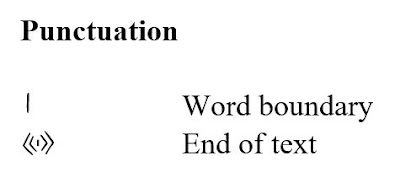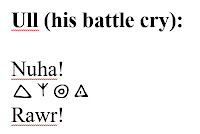Some definite similarities, but you can see that a number of changes have been made.
Okay, so how does the script work? First & foremost, the Izila script is an alphabet, with characters that represent both vowels and consonants. The original idea was that the Izila invented a writing system to communicate with their celestial gods: Mensi & Suxli. Tensay learned the writing system while he was a slave of the Izila and brought it back to the Wenja village. (NOTE: THIS IS NOT CANON)
Each letter has a name in Izila: < p > is pód, < b > is bárs, etc. Each letter is based off of the first sound of the picture it represents. So, the picture of a foot stands for the letter < p >, because pód, the word for "foot" in Izila begins with a "p". This is a process called acrophony and is actually how our alphabet originally came into being (see here).
The letters themselves are arranged as only a linguist would -- stop consonants are first, moving from the front of the mouth to the back, then fricatives, then nasals, liquids, glides, and finally vowels. There are two letters with dual functions. The letter ulóm "owl" represents both < w > and < u >, and the letter yugí "eternal life" stands for both < y > and < i >. You can see this in two of the examples below. yugí represents < y > in Sayla, but < i > in pati. Similarly, ulóm represents both < w > and < u > in the name Wuga.
When a writing system is first invented (as occurred in the ancient Near East, China, or Mesoamerica), it starts off with letters that do not just represent sounds, but also letters that represent words (i.e., morphemes). Such characters are called logograms. There are a handful of these in the Izila script.
What this means is that you would never write out the words "Izila", "Wenja", "Udam", etc. using the phonograms listed above. Rather. you would use one of these special signs.
In addition, there are also additional logograms that can function as determiners, signs that you place before a specific concept to indicate what type of entity that thing is. If the noun in question is an animal, a man, a woman, a god, a spirit, or a tribe, you'll place one of these determiners before it. You can use these symbols as logograms as well.
Finally, there are two types of punctuation in the kraybati -- a word-boundary marker and a final symbol that indicates the end of a text.
Allow me to explain logograms, determiners, and punctuation markers with the sentence below.
Let's first transcribe the writing systems directly into what it says. I've used colons to indicate word boundaries, # the end of text marker, capitalized all logograms, and superscripted any determiners.
smarkaka:mw:MANWENJApaty:hay:nawa:kraybaty:TRIBEWENJAs#
Let's begin with the word "Winjapati", the third word in the line. It begins with a determiner hnér, which marks that the person in question is a man. Essentially, it's like an unspoken "Mr.". If I were a woman, I'd use the sign gwéni. The determiner hnér is then followed by the logogram WENJA and then the phonograms < p > < a > < t > < y >, resulting in Winjapati. Later in the line the logogram WENJA reappears, but this time it's preceded by génhos, indicating that this Wenja is referring to the tribe (or language).
As with much of what we have done in Far Cry Primal, this writing system is based in a certain amount of reality. There are a set of symbols called the Vinča Script (Vinča = Winja.... it's too perfect.), which were first used roughly 10,000 years ago. Though many call it a "script", it's unclear if it was actually one. (Highly unlikely that it was). The symbols used above are taken from the Gimbutas font, designed by Prof. Sorin Paliga, a linguist at the University of Bucharest, Romania. Visit here for a fuller discussion, with references, of the Vinca script and a link to the truetype font so you can make your own Wenja texts.
I'll conclude this post with a sample of some of my favorite lines from the game, written in the Izila script.


















No comments:
Post a Comment